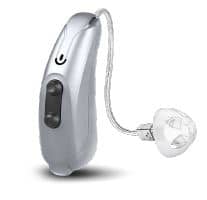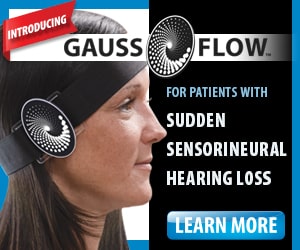by Brian Taylor, AuD, Editor-At-Large

Brian Taylor, AuD
That two-thirds of adults do not wear hearing aids, primarily due to high retail costs, is a well-worn industry trope. A recent paper in JAMA Otolaryngology by two Northwestern University researchers, entitled Barriers to Hearing Aid Adoption Run Deeper Than the Price Tag, sheds valuable light on other reasons for non-use. According to the authors, “focusing on cost as the sole barrier to hearing aid uptake is overly simplistic and perhaps a hindrance to a more effective solution.”
If retail costs were the main barrier to hearing aid use, countries with programs that keep out-of-pocket costs extremely low would see a much higher rate of hearing aid use. The data from several studies, as cited n this paper, does not support the assertion that cost is the primary barrier to non-use of hearing aids.
The authors focus their attention on the concept of perceived benefit, which is a combination of monetary value and the social value of hearing aids. The authors suggest the subsidies provided by some countries that cover much of the out-of-pocket costs of hearing aids do not outweigh the lack of perceived social value for many individuals who might otherwise benefit from hearing devices. Social value, as defined by the authors, “is the sum of self-perceived benefit and benefit perceived by others related to the purchase of a product.”
To support their point, the authors cite a German survey in which the top five reasons for not seeking hearing aids were:
- Physical comfort
- The inability of hearing aids to restore natural hearing
- Hearing well enough in most situations
- Hearing loss not severe enough
- Having more serious priorities.
Of course, social value is likely linked to all five of these self-reported barriers.
Perhaps the most valuable part of this paper is the authors’ reflections on the concept of locus of control (LOC) and how LOC influences personality traits. Locus of control refers to the extent by which individuals believe they have control of their own life outcomes. People with an externally focused LOC believe their outcomes are out of their control and are a result of factors such as luck or fate. As the authors point out, an individual with an external LOC who has hearing loss would not be motivated to seek hearing aids unless they were recommended by a trusted expert such as a physician.
In contrast, individuals with an internal LOC believe that life outcomes are consequences of their own actions – that a person determines their own fate. An individual with an internal LOC who experiences hearing loss would be self-driven to seek hearing aids without the need to be validated by others. Locus of control shapes, as the authors suggest, shapes how a person plans to acquire hearing aids but also underlying personality factors and stigma.

Three interconnected traits related to hearing aid uptake, all independent of price.
Finally, the authors state, “we believe that personality traits and LOC are intimately intertwined and have an undeniable influence on hearing aid uptake, independent of the price tag.”
For clinicians who interact with persons with hearing loss every day, many of which are often in serious need of amplification, the insights from this paper suggests many non-audiological characteristics are critical in the treatment planning and goal setting process — not to mention helping individuals with hearing difficulties navigate the self-discovery process that amplification might be beneficial — and well worth the time trying to better understand prior to recommending hearing aids, regardless of their retail price.







How about the fact that basic hearing (and eye) tests are no longer a part of your yearly “physical” which means that hearing (and vision) issues are often not “caught” until so much hearing has been lost that the transition to aids is very difficult. If we had an annual hearing and eye checkups as I did as a small child, how many issues might be discovered when correction would be an easy transition and since recommended by your general physician would folks be more willing to look into correction? However, correction then needs to be economically reasonable!
I can attest that all five issues affect me and that cost is a major factor as well. I also believe be that although I am motivated to take control of solving problems there are factors beyond control that affect my ability to always do so in a timely manner.
Another issue is lack of well-trained technicians selling the hearing aids and not truly being able to work the software to properly adjust the hearing aid software to the needs of the individual. I’ve worn hearing aids for decades and there is a constant turnover of the technicians selling the hearing aids. They always want you to upgrade to the latest technology but don’t even seem to be able to effectively set up the current hearing aids to their fullest effectiveness. Oftentimes the technician (who is rarely an audiologist) seems to blindly trust whatever setting the software deems is appropriate after a hearing test, which is rarely even close. Then they randomly adjust and fiddle with software settings and then ask you “how does that sound?’ while you’re sitting in a totally quiet, insulated room with nothing to listen to to gauge the new settings of the hearing aids. By this point my frustration level is peaked and I’m about ready to leave the office. This has nothing to do with price or my locus of control. What we need as wearers of hearing aids is control to completely have access to all the settings so that we can adjust them on our own based on what we are hearing vs having to rely on an ineffective lexicon to try and communicate our hearing needs to a technician. Like going to a store and having someone else try a pair of shoes on for us and then asking us how we like them.
Great points you raise! I was an owner/operator in the hearing aid business for 8 years and one of the most challenging things was the turnover. I agree that facilitating real time adjustments would be helpful! Remote programming can help with that if it’s enabled in the software of the hearing aid and allowing an app to modify the settings with greater sophistication would be even better. Perhaps developers question the abilities of the user to know what they need to change and worry about complexity further deterring hearing aid adoption… There is one measurement I wish more people knew about that’s called Real Ear Measurement which actually measures the performance of the hearing aid in the ear canal. If this measurement is performed, it can ensure that the hearing aid is matching the hearing loss and therefore coming as close to natural hearing as possible. I recommend you ask every practitioner you work with to perform this measurement whenever your annual test is performed or when it sounds like the hearing aid isn’t working well!
Yes I have asked about Real Ear Measurement but have not been able to have this performed. The company where I bought my current hearing aids (which is a major national provider) does not offer it where I live but said I could travel to another city a couple hours away to get one done (which really surprised me when I found out about it and asked because I thought this was supposed to be the standard). So now if I want that done, I would have to take a road trip or find a different hearing aid provider (and thus new hearing aids) as I doubt a different provider would do that service for me without a fee. I don’t even think the location I go to has an actual audiologist on staff. Seems like there should be higher standards for who is qualified to sell hearing aids. Many hearing aid customers are elderly, many who are retired and have less rigorous demands for their hearing aids and are likely not going to be powerful advocates for their needs. I’ve seen this first-hand while in the waiting room and often feel bad for the elderly customers who appear to have some cognitive issues and have difficulty understanding the technician who is eagerly trying to get them to take the aids and head on out the door. I am at the point that I have four-year-old hearing aids but don’t want to mess with them for fear of ending up with a worse product, which was the case a year ago when I tried the “new” technology which actually was much worse.
A couple of observations : Firstly, the high turnaround of audiologists is mainly due to salary issues and lack of proper understanding among the MD and the professional. This accounts for a higher turnaround, and this is not acceptable as patient trust is broken, and it takes a long time to heal the damage caused. Then is the issue of REM tests, done in second tier HA offices. The settings recommended through the REM cannot be perfect because we are dealing with nerve damage in the cochlea, the wear and tear on the myelin sheaths on the 8th nerve, and the tolerances that change on the neuron loads in the hippocampus. The settings need frequent changes in steeply sloping hearing losses that are also neurosensory. Understanding the nature of manipulating such HA fittings need advanced study of neurology, especially for complex asymmetrical hearing losses. Hearing aid settings need better clinical attention, and this comes about with regular adjustments.
For the past 4 years our HLAA Hearing Tech Expo has offered free trials of the top 6 hearing aid manufactures’ products following a hearing screening and counseling from an audiologist which each trier had to go through to guide them on which specific hearing aids they should try. After completing the trials which allowed people to compare several hearing aids, the vast majority said they would have bought a recommended hearing aid if their hearing care professional had provided the trials. Only 20% had a financial issue with not being able to afford the device. Our event did not allow the sale of any devices from 75 exhibitors, only the ability from attendees to either take home a free amplified phone from one of the exhibitors there or set up an installation of free captioned phone or video service from the up to 6 exhibitors present. We did hear from a few attendees that returned to their hearing care professional to buy the device they tried, but we did not have a way to monitor the full samples each expo. However it was clear that the vast majority of our triers found the lack of being able to try the device before purchasing it the real barrier as they can do that with so many electronic devices, but not hearing aids. If there are any follow-up questions, you can reach me at [email protected].
When I was dispensing, and later manufacturing hearing aids, I always offered a trial period and more often than not insisted on one. I also tried to make clear that acquiring a hearing aid was a journey on which the patient and I were traveling together, possibly along with family members and friends. Acceptance was nearly universal, but for some the initial leg of the journey was longer than for others.